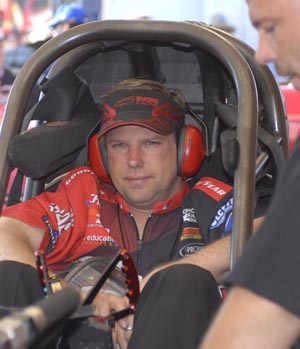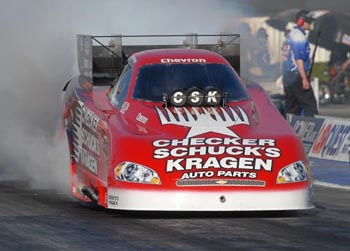SIDEBAR - DEL WORSHAM’S THOUGHTS ON ARMSTRONG’S PLAN

CompetitionPlus: Armstrong’s concept is a lower compression ratio engine with less blower drive, and you suggested you could overcome that. How would you go about doing that?
Del Worsham: Well, there are certain points of limitation on everything. It would depend on how low you really want to go with the compression, and how low you want to go with the blower (overdrive). There are still lots of ways to overcome these things, through static compression or timing or something like that.
This year is a pretty good example because we went back to 90 percent nitro. When we did that we modified our blowers and changed things around so we’re running about 10 lbs. less boost than we ran last year at right around the same compression. With the timing we run our car hasn’t slowed down at all.
It just appears to me that there are ways around just about anything at this point.
The ground’s going to shake, the nitro’s going to burn your eyes, there’s gonna be smoke, there’s gonna be header flames, there’s going to be great racing…I think we’re all going to think this isn’t such a bad thing.
CP: In general, do you think a static compression ratio rule would work if it was policed effectively?
DW: You would think it would have to help to a certain degree. What I’m not sure about, and wish I did know, is at what speed are we (safe) clearing the top end of the track with the shut-down area we have available? What speed is really acceptable and safe? What are we looking for in that area? I don’t know if even 315 mph is (too fast) for some of the tracks we run on in case there’s a huge problem, to give the driver a chance. That’s what I wish I knew.
CP: Do you think a static compression ratio rule might lower the costs?
DW: It might. In reality, right now, the way things are now, we’re not going through very much damage on our cars right now. With 90 percent nitro and the way we’re running our blowers and things, the damage is minimal. We’re okay with pistons and rods, but we’re still having issues with crankshafts. If (a lower compression ratio) could help us with crankshafts, and we’re looking at about $3,900 for those right now and we use one in each race – and that seems a little excessive to me – that would help. The problem is that everything else around (those engine internals) has gone up so much that we’re feeling it (financially).
a d v e r t i s e m e n t
Click to visit our sponsor's website

DW: Well, obviously Pomona has its fair share of issues. It’s not only that it’s short, it’s bumpy, so when you try to stop it’s hard to get stopped. I noticed this week in Norwalk, and I never really paid attention to this, but even pulling two parachutes and using some of the brakes, it wasn’t a problem to make the final turn. There was no reason for (the Safety Safari) to pull you off the track if you made a full run because even with two ‘chutes out you’d be whipping around that corner really fast. Norwalk, I thought, could be a bit longer, and we never ran over 307 mph there, and I still found myself coming up on the end of the track very, very fast.
CP: Is there anything coming up on the horizon, or not being used now in the braking department that would be an improvement?
DW: A lot of that depends on the track again, ‘cause if you get a lot of hopping (bouncing) going it becomes that much harder to stop. Maybe we have to use our front brakes more than we have been. We have proportioning valves to balance the brakes between the front and the rear, and maybe we need more on the front. I’ve heard that Roger Lamb and his family (Lamb Components) are developing a four caliper system right now to insure that there’ll be plenty of braking for everyone.
I definitely respect everything Dale Armstrong says. He probably knows nitro racing better than anyone I know.
I definitely respect everything Dale Armstrong says. I’ve spent many hours riding in planes with him, and we’ve had numerous discussions on this kind of stuff. He probably knows nitro racing better than anyone I know. In terms of slowing the cars down and changing things around, I’m sure he’s right.
I’m kind of concerned that if we do come up with a static compression ratio that we’re basically going to have to have Pro Stock engines on nitro, which means they’re going to have to be kept absolutely perfect as far as ring seal, the blower being perfect, the motor being put together and sealed up properly. Everything’ll have to be perfect. Every run we make will become a huge deal (in terms of maintenance), and I don’t know if we’re ready for that or not.
CP: How difficult do you think things might be in Denver this coming weekend with new tires, new chassis, running to 1,000 feet and that there are two transitions on the track, from the cooler first 240 feet of the track because of the underground cooling system, and then the rest of it.
DW: Well, I’ve heard that a blown alcohol dragster recently went 270 mph up there, which is absolutely unbelievable, which tells me the track’s a lot better than it was, so it should be good. The tire thing really doesn’t seem to be too much of an issue. Any time you go to Denver you just don’t know what you’re going to get. You can go there like we did in 2002 and win the race and qualify Number 16, and then go there in 2003 and hardly get down the track. When you go to Denver it’s kind of an unknown for everybody.
The thousand foot thing, wow, I don’t think any of us are going to, including the fans, are going to know that much (about what’s going on). Basically, a good run at a good track is 4.7 seconds. We’re still going to be running four second runs. We’re basically only talking about “losing” a few tenths of a second (with the shorter track), so other than looking at a little bit different E.T.s and maybe the speeds will be a little different, the excitement level’s still going to be there. The ground’s going to shake, the nitro’s going to burn your eyes, there’s gonna be smoke, there’s gonna be header flames, there’s going to be great racing, and I think once we get used to this I think we’re all going to think this isn’t such a bad thing.
| {loadposition feedback} |



